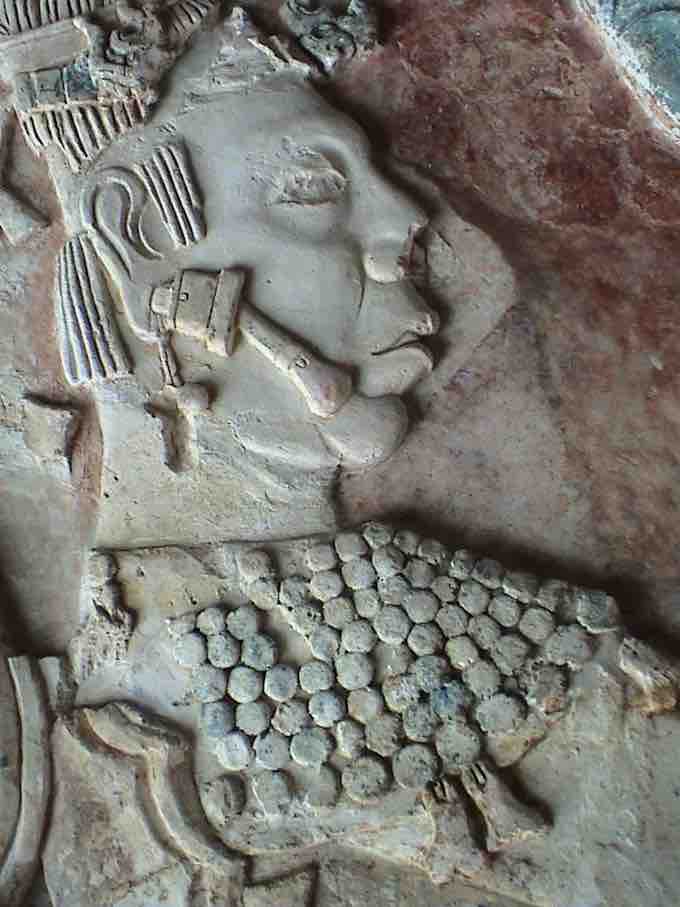Mesoamerica is a region in the Americas that extends from central Mexico to northern Costa Rica. There are three cultures that dominated the pre-columbian history of Mesoamerica: the Olmec, Maya, and Aztec civilizations.
Olmec Culture
The Olmec civilization, which flourished from 1200–400 BCE, defines the Pre-Classical period; the Olmecs are generally considered the forerunner of all later Mesoamerica cultures including the Maya and Aztecs. Primarily centered in the modern states of Tabasco and Veracruz in the Gulf of Mexico, the Olmec people are known especially for creating an abundance of small and extraordinarily detailed jade figurines. The figurines typically exhibit complex shapes such as human figures, human-animal composites (or hybrid forms) of deities/gods, and animals specifically cats and birds. Although we don't know the specific purpose of these jade objects, their presence in some Olmec graves suggests they served a largely religious purpose in addition to being signs of wealth and goods for trade.
Olmec jade figurine
Small holes were drilled around the edges so that this figurine could be worn on the body with twine.
The Olmec are also known for building massive stone sculptures many of which were discovered at La Venta in the modern Mexican state of Tabasco. Made from basalt rock from the Tuxtla mountains to the north, the Olmec used this rock to create altars, stelae, and colossal heads. Each colossal head is rendered as a distinct individual and are thought to resemble different Olmec rulers. Each ruler's personality is represented in the distinct headdress that adorns each sculpture's head.
Olmec colossal head
Heads like this one made from basalt boulders weighed anywhere between 6 and 50 tons.
Maya Culture
Maya culture reached its peak during the Classical period (ca. 200–900 CE). Organized in large, agricultural communities ruled by monarchs, their culture was extremely complex. They built imposing pyramids, temples, palaces, and administrative structures in densely populated cities in southern Mesoamerica. The Maya had the most advanced hieroglyphic writing in Mesoamerica and the most sophisticated calendrical system. In Maya culture, we also see one of the earliest systems of art patronage. Kings and queens employed artists full time in their courts, and many of those artists signed their work. It's not surprising then that the most common motifs in Maya art are mortal rulers and supernatural beings.

Mayan relief sculpture from Palenque, Mexico
The Maya were among the most advanced cultures of Mesoamerica. Most of their art are representations of mortal rulers or mythic deities.
In Palenque, Mexico (a prominent Maya city in the Classical period), the ruler Lord Pakal commissioned a grouping of large structures that stand on high ground in the middle of the town. One of those buildings, the Temple of the Inscriptions, is a nine-level pyramid that is 75 feet high. The layers of the structure probably reflect the Maya belief that the underworld had nine levels. Inscriptions line the back wall of the temple, giving the building its name.
Temple of the Inscriptions, Palenque, Mexico
The Temple is one of four structures commissioned by the Maya ruler Lord Pakal.
Aztec Culture
Maya civilization was in decline by the time of the Spanish Conquest in the early 16th century, and by then the Aztecs controlled much of Mexico. The rise of the Aztec was quick. Once a migratory people, they arrived in the Basin of Mexico in the 13th century where they eventually settled on an island in Lake Texcoco; they called their new home Tenochtitlan. In only a few centuries, the Aztec had aggressively expanded their territory and transformed Tenochtitlan into a capital so grand that the Spanish conquistador Hernan Cortes remarked on its beauty en route to sack the city in November 1519.
Metalwork was a particular skill of the Aztec. Unfortunately very few examples of these small gold and silver objects survive. When the Spanish arrived, most of these objects were melted down for currency. Stone sculpture and wood figurines fared much better during the Conquest. Aztec sculpture, most of which took the form of human figures carved from stone and wood, were not religious idols as one might suspect. Some of these figures were monumental in size and instead of containing the spirit of a deity, sculptures were made to 'feed' the deities with blood and precious objects in order to keep the gods, who resided elsewhere in the temples, happy. The Aztec need to 'feed' the gods in this way are the source of stories told by the Spanish conquistadors of huge statues splattered with blood and encrusted with jewels and gold.
15th century CE vase representing Tlaloc, the Aztec god of rain, storms and agriculture
The vase is from the glittering Aztec capital of Tenochtitlan.